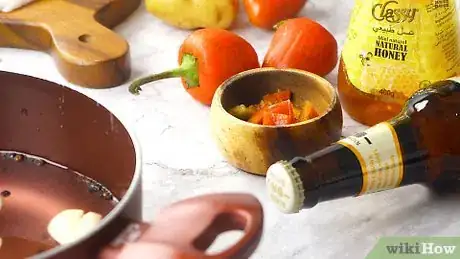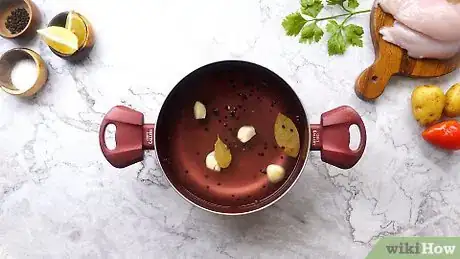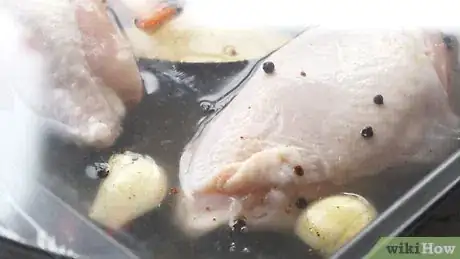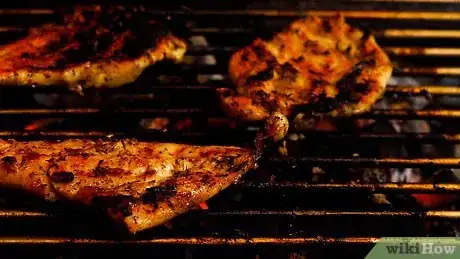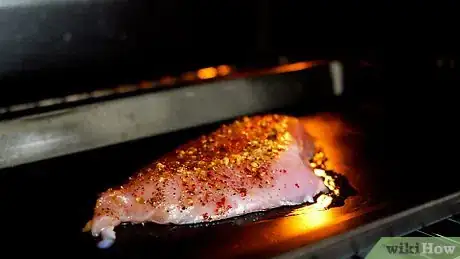This article was co-authored by Jillian Fae Downing. Jillian Fae Downing is a Private Event Chef, Chef Educator, and the Owner of Jillian Fae Chef Services based out of Temecula, California. With 12 years of experience, she specializes in menu planning and menu research and development. Jillian Fae holds an Associate of Science in Culinary Arts from Orange Coast College and a BA in Mass Communication and Media Studies from Arizona State University. She is also a member of the American Culinary Federation and the American Personal and Private Chef Association.
There are 13 references cited in this article, which can be found at the bottom of the page.
wikiHow marks an article as reader-approved once it receives enough positive feedback. In this case, 91% of readers who voted found the article helpful, earning it our reader-approved status.
This article has been viewed 325,820 times.
Chicken is great all-purpose meat, but it can dry out easily when you cook it. Keep your chicken from drying out by brining it first. A good brine not only adds flavor to lean meats like chicken breasts, but also helps keep it juicy no matter how you cook it. Make a brine by dissolving salt, sugar, and seasonings in water and allow your chicken to sit in the mixture for a little while. Then, cook it to your liking.
Steps
Making a Basic Brine
-
1Dissolve four tablespoons of salt into a quart of water. A brine, at its most basic level, is nothing more than salt dissolved in water. Different people like different ratios of salt in water, but a good ratio to start with is four tablespoons (about 60 grams) of salt for each quart (0.95 liters) of water. Add the salt to hot water and stir it until it has dissolved completely.[1]
-
2Add two tablespoons of sugar. Not all brines require sugar, but it’s a good idea for chicken. Sugar will help the outside of your chicken breasts brown and caramelize better when they cook. While your brine water is still warm, add about two tablespoons (30 g) of brown sugar to your brine, and stir until the sugar is fully dissolved.[4]
- Alternatively, other sweeteners like honey, agave syrup or maple syrup can be used within your brine.[5]
Advertisement -
3Season your brine with pepper, lemon juice, garlic, and herbs. The exact seasoning you use will depend on what flavors you want in your chicken, but many brines have a few basic seasonings. You can use a combination of fresh or dried herbs, garlic, spices, and peppercorns.[6] A teaspoon (5 g) of black peppercorns, two to four peeled and smashed cloves of garlic, a squeeze of fresh lemon juice, and a bay leaf per quart of water will add some subtle flavor to your chicken.[7]
-
4Flavor your brine. Some brines should be flavored instead of seasoned. If you want your chicken to have a particular flavor once it is cooked, such as honey butter or hot and spicy, you can start building that flavor in your brine. There are a number of brine recipes in books and online to help you find your perfect flavor.[8]
Enhancing Your Brine
-
1Make a honey butter brine. For a sweet brine perfect for honey butter chicken, use the standard water to salt ratio. Instead of sugar, swap in an equal amount of honey. Season with whole peppercorns and fresh herbs such as thyme and rosemary to your liking.[9]
-
2Add a spicy flavor to your brine. Make a spicy brine by adding two to three seeded jalapeno or habanero peppers and a dash of smoked paprika to your basic water, sugar, and salt brine, along with garlic cloves and peppercorns to taste.
-
3Brine your chicken using beer. If you are going to roast your chicken, make a standard brine but substitute one cup (237 ml) of stout beer in your solution. Add a couple dashes of Worcestershire sauce and use maple syrup or molasses instead of sugar in equal parts.[10]
-
4Cool the brine before adding in the chicken. Never add a warm brine to your chicken. That creates a perfect environment for bacteria to thrive. Allow your brine to cool until it is room temperature, or pop it in the fridge to cool it off faster. Alternatively, you can also add ice to cool the brine down quicker.[11]
Adding Chicken to the Brine
-
1Trim fat and tendons off your chicken. You can put your chicken in a brine fresh or frozen. Before you brine, though, prepare your breasts by trimming away any fat or tendons. Fat is typically a white or creamy color and will be around the edges of the breast, while tendons will be tough, reddish spots.[12]
-
2Put your chicken in a pan or bag. You can put your chicken in either a large, shallow pan or a sealable bag to brine. If you choose to put your chicken in a pan, lay the breasts out side-by-side, making sure they do not overlap.[13]
-
3Add your brine. Pour your brine into your container over your chicken. There should be enough brine to completely submerge your chicken. Seal your bag and roll it lightly to get your brine into all areas of the chicken. If your meat is in a pan or dish, cover it with foil or cling wrap.
-
4Put your chicken in the refrigerator and allow it to rest in the brine. The longer your chicken rests, the juicier and more flavorful it will be when you cook. Brine your chicken for an hour for every pound of meat.
- Larger chicken breasts or large quantities of chicken may be brined overnight to get the best flavor and texture.
- You can quickly brine your chicken by splitting it up into half-pound (227 g) servings and letting each one soak in their own dish or bag for one and a half to two hours.[14]
-
5Remove your chicken and pat it dry. Once you brined your chicken, remove it and let it rest on a plate for at least five minutes. This allows the excess juices to drain off your chicken breasts. Then, use a paper towel and gently pat away any excess moisture from the breast’s surface.[15]
- Some people choose to rinse their chicken after brining it. This helps keep the chicken juicy and leaves a more mild flavor.
Cooking Your Brined Chicken
-
1Grill chicken immediately out of the brine. Grilling brined chicken gives the meat a crispy outside and a tender, juicy inside. Cook your chicken on medium-high heat of 375 to 450°F (190 to 230°C) until the outside of your chicken is golden-brown and the inside is up to a temperature of 165° Fahrenheit (75° Celsius).[16]
- Working over direct heat, chicken breasts can cook quickly. There is no set time for grilling chicken, though. Just be sure to check the inside and make sure it is cooked fully.
-
2Bake tender chicken breasts. Baked chicken often comes out dry. Brined chicken, though, typically comes out juicy and tender after the baking process. Preheat your oven to 450°F (230°C) and season the chicken with salt, pepper, and other seasonings to taste. Then, place the breasts in a greased dish and cook for 20 to 25 minutes, or until your chicken reaches 165°F (74°C) internally.[17]
- You can use a meat thermometer to monitor the internal temperature of your chicken. If the outside is cooking too fast, turn the temperature down to 400°F (204°C).
-
3Fry your chicken. Much like baking, frying can dry out chicken. Brining helps keep the breasts tender. Batter the chicken in your favorite batter and deep fry in oil that has been heated to about 350°F (176.6°C) for five to seven minutes on each side, depending upon the thickness of your cuts.[18]
Community Q&A
-
QuestionHow long should you brine chicken breast for?
 Jillian Fae DowningJillian Fae Downing is a Private Event Chef, Chef Educator, and the Owner of Jillian Fae Chef Services based out of Temecula, California. With 12 years of experience, she specializes in menu planning and menu research and development. Jillian Fae holds an Associate of Science in Culinary Arts from Orange Coast College and a BA in Mass Communication and Media Studies from Arizona State University. She is also a member of the American Culinary Federation and the American Personal and Private Chef Association.
Jillian Fae DowningJillian Fae Downing is a Private Event Chef, Chef Educator, and the Owner of Jillian Fae Chef Services based out of Temecula, California. With 12 years of experience, she specializes in menu planning and menu research and development. Jillian Fae holds an Associate of Science in Culinary Arts from Orange Coast College and a BA in Mass Communication and Media Studies from Arizona State University. She is also a member of the American Culinary Federation and the American Personal and Private Chef Association.
Private Event Chef & Chef Educator If it's just the breast, you'd need much less time than you would a whole chicken. You typically only need to brine chicken breast of about one and a half to two hours and that’s enough time for the brine to penetrate.
If it's just the breast, you'd need much less time than you would a whole chicken. You typically only need to brine chicken breast of about one and a half to two hours and that’s enough time for the brine to penetrate. -
QuestionWhat is the formula for brine?
 Jillian Fae DowningJillian Fae Downing is a Private Event Chef, Chef Educator, and the Owner of Jillian Fae Chef Services based out of Temecula, California. With 12 years of experience, she specializes in menu planning and menu research and development. Jillian Fae holds an Associate of Science in Culinary Arts from Orange Coast College and a BA in Mass Communication and Media Studies from Arizona State University. She is also a member of the American Culinary Federation and the American Personal and Private Chef Association.
Jillian Fae DowningJillian Fae Downing is a Private Event Chef, Chef Educator, and the Owner of Jillian Fae Chef Services based out of Temecula, California. With 12 years of experience, she specializes in menu planning and menu research and development. Jillian Fae holds an Associate of Science in Culinary Arts from Orange Coast College and a BA in Mass Communication and Media Studies from Arizona State University. She is also a member of the American Culinary Federation and the American Personal and Private Chef Association.
Private Event Chef & Chef Educator My go-to formula is typically one gallon of water to one cup of salt to a half cup of sugar — you can also use other sweeteners if you're looking for a different flavor element. If you're doing a small amount of breast, obviously, you could scale down the brine.
My go-to formula is typically one gallon of water to one cup of salt to a half cup of sugar — you can also use other sweeteners if you're looking for a different flavor element. If you're doing a small amount of breast, obviously, you could scale down the brine.
References
- ↑ Jillian Fae Downing. Private Event Chef & Chef Educator. Expert Interview. 2 September 2021.
- ↑ http://www.bonappetit.com/uncategorized/article/does-it-matter-what-kind-of-salt-you-use
- ↑ http://www.thekitchn.com/use-a-quick-brine-to-make-any-cut-more-tender-47879
- ↑ http://www.cookshack.com/store/Smokin-Okies-101-Series/Brining-101
- ↑ Jillian Fae Downing. Private Event Chef & Chef Educator. Expert Interview. 2 September 2021.
- ↑ Jillian Fae Downing. Private Event Chef & Chef Educator. Expert Interview. 2 September 2021.
- ↑ http://www.thekitchn.com/weeknight-meal-tip-try-a-quick-95560
- ↑ https://www.realsimple.com/food-recipes/recipe-collections-favorites/brine-recipe
- ↑ http://allrecipes.com/recipe/221227/honey-brined-fried-chicken-breasts/
- ↑ https://www.realsimple.com/food-recipes/recipe-collections-favorites/brine-recipe
- ↑ Jillian Fae Downing. Private Event Chef & Chef Educator. Expert Interview. 2 September 2021.
- ↑ http://thefitchen.com/how-to-trim-chicken-breasts/
- ↑ https://www.gimmesomeoven.com/baked-chicken-breast/
- ↑ Jillian Fae Downing. Private Event Chef & Chef Educator. Expert Interview. 2 September 2021.
- ↑ http://www.southernliving.com/food/how-to/chicken-breast-brine-video
- ↑ http://www.seriouseats.com/2012/06/hot-to-grill-boneless-skinless-chicken-breast.html
- ↑ http://www.fortheloveofcooking.net/2015/05/brined-and-baked-chicken-breasts.html
- ↑ http://www.epicurious.com/recipes/food/views/brined-fried-chicken-352449
About This Article
To brine a chicken breast, start by dissolving salt and sugar in water. For more flavor, you can also add pepper, lemon, garlic, and herbs. Next, trim the fat and tendons off your chicken and place it in a pan or resealable bag. Add enough brine to submerge your chicken, and refrigerate it for several hours or overnight. Once the chicken is done, remove it, let it rest on a plate for 5 minutes, and pat it dry. For tips on how to cook your brined chicken, keep reading!

